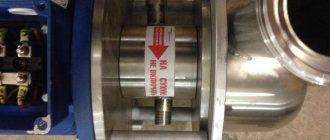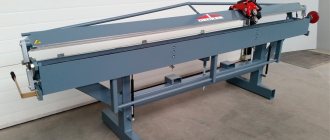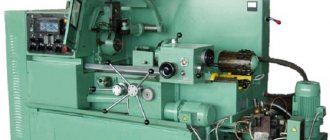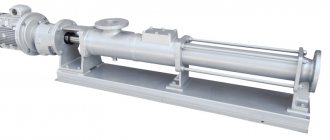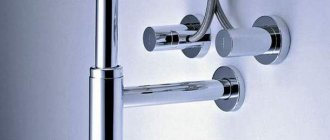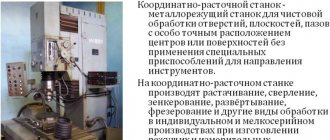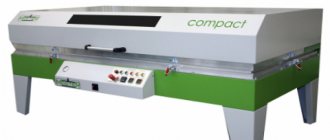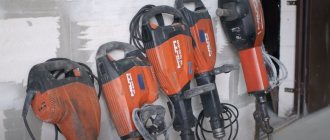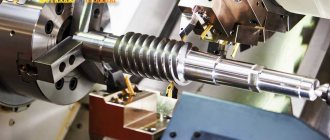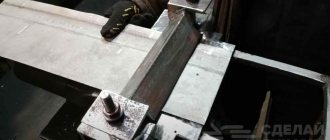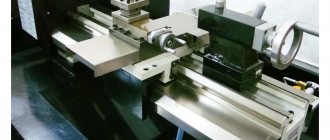Various products and blanks are made from metal, which are used in the construction of a house, in everyday life or for other purposes. Such products can be metal profiles, signs and stands of various sizes, metal boxes, construction corners, segments and many other items.
To give a metal product a certain shape, the sheet bending method is used. In this case, the outer layers of the sheet are stretched, the inner layers are compressed, and those located along the axis remain unchanged.
You can bend or bend a sheet blank using special equipment for bending the material, varieties of which have different design solutions and several areas of application. They also differ in price equivalent, depending on its functionality, power and type of work that will be performed.
Design features of the bending machine
Equipment for bending metal sheet blanks has a rather intricate design. The machine is made up of parts:
- special table for back support. A metal sheet is placed on it. The workpiece will move along it in the desired direction. There is a special bender and a sharp cutter on the supporting supports;
- roller blade for cutting. This knife is usually very well sharpened and durable so that it can easily withstand the load and easily cut through a hard metal sheet;
- stops located in front - used to regulate the width of the cut being made;
- height parameter fixers. They adjust the height of the workpieces.
The length parameters and the size level of the maximum thickness of the product to be processed differ for different types of machines.
Design and principle of operation
The bending machine consists of the following elements:
- work table for placing the workpiece, fixing it in the desired position;
- cutter, bending beams, fixed to the table;
- roller-shaped knife;
- front stops for adjusting the width of the workpiece;
- a wooden stand that acts as a support;
- goniometer to determine the cutting angle;
- height fixing parts.
The main material from which machine parts are made is structural steel. The traverse is an exception, so it is recommended to replace it with a steel channel that can withstand the same load along its entire length due to stiffening ribs.
The principle of operation is based on rigidly fastening the sheet along the bending line and applying external forces to the loose part until the required bend angle is obtained.
Kinds
In industry and construction, machines are used to give the desired shape to metal products, namely:
- a manual machine is a small-sized technique. This makes it easy to rearrange. Due to its light design and small number of functions, it cannot be used for large-scale work. With its help, copper parts, steel or galvanized aluminum workpieces are shaped. Working with this machine does not require special training, but it takes a lot of time and requires a lot of effort;
- mechanical machines. They function by supplying power from a rotating flywheel that is started to spin in advance;
- Electromechanical structures operate using an electric motor, a special device - a gearbox - using belts and a drive. Machines of this type are more powerful compared to mechanical equipment and more productive;
- hydraulic structures. These machines shape metal workpieces using a special cylinder arrangement;
- pneumatic machines perform work using pneumatic cylinders that bend sheet blanks with special paint applied to them;
- electromagnetic structures are used to create metal boxes. Metal blanks are bent under the influence of a powerful electromagnet. Therefore, they can involve processes that require enormous amounts of effort and energy;
- Mobile sheet benders are small machines. Due to the design properties, they can be used to process workpieces and parts immediately at the site of future assembly of parts.
General characteristics of sheet metal bending machines
Specialized machines that are used for metal processing of steel sheets are called sheet benders.
This type of machine produces a wide variety of steel products through “cold bending of metal.” This type of product includes a variety of flashings, façade cassettes, metal additional elements for roofs or siding, and building profiles. The production of various signs, letters, shelves, signs, stands, closed parts, corners, cylindrical parts, boxes, ebbs, segments and so on has always been in great demand. In addition to the above, thanks to the capabilities of the sheet bending machine, it is possible to produce a wave profile and bend in various directions. The list of sheet bending machines is not limited to the above capabilities, since each machine may have features characteristic only of a particular model. For example, there are sheet benders that are capable of cutting metal! But in general, sheet bending machines have found their place in metal processing, since their operation radically reduces fabulous production costs.
Sheet benders, in their operation, are an elementary mechanism with which you can very quickly and easily produce sheet iron products of various sizes and shapes. When operating a sheet bending machine, there is no need for high-temperature production equipment, since all types of work can be performed thanks to the cold type of iron processing. This opportunity appeared almost immediately after the invention of the first sheet bending machine.
Classification of sheet bending machines.
Nowadays, there are many types and modifications of sheet bending machines, differing both in capabilities and in appearance. Sheet benders are divided into three main types, depending on the installation method: stationary and mobile.
According to the bending method, there are sheet benders: press benders with a matrix and a punch; rotary with a bending beam and rotary with 2, 3, 4 rolls.
If we consider that products made from sheet iron have a wide range of uses, then it turns out that the range of applications of the sheet bender is very extensive! The production of a sheet bender is characterized by low cost, excellent reliability, and that is why the sheet bender is not an additional equipment, but a mandatory one!
Unfortunately, in the practice of do-it-yourselfers, the sheet bender is a very rarely used device. Despite this, it still remains very useful, because with its help, even a novice master can perform any work that involves bending metal, without any unnecessary deformation! Everything will be performed strictly at a given angle.
But if we talk about professional craftsmen, then the sheet bending machine will simply be a real find, since it is able to provide the highest quality in the production of such products as chassis, housings, casings, and so on, guaranteeing the most excellent appearance of the product!
Benefits of use
Like any other equipment, these devices have pros and cons. undoubted advantages are that:
- the products obtained during operation are highly durable;
- using the machine, you can bend the sheet at an angle without forming any seam on the workpiece;
- the formation of bend corrosion is practically eliminated;
- bending machines allow you to create a solid metal structure.
Thus, you can create products of the highest level of quality without fear that they will have certain flaws or be subject to adverse effects.
The operating principle of different types of sheet benders
Using modern profile equipment, it is possible to create products of various shapes from sheet blanks. In this case, the dimensions of the workpieces can be specified in advance.
Manual devices
These machines are characterized by maximum thickness, bend length and are determined by the depth of metal feeding.
Operating principle of the machine:
- the metal workpiece used for work is pressed onto the table due to a special beam;
- the material is bent at the desired angle. It is important to take into account that the bend of such a manual unit should have a thickness of approximately 2 mm.
Due to the fact that manual machines are compact in size and weigh very little, you can work with them not only in the workshop. They are used for processing workpieces immediately at a construction site or in another room.
Hydraulic technology
With its help, you can significantly simplify the process of processing metal parts. They function as follows:
- energy is generated through the liquid located in a cylinder installed in the machine. The liquid, using pressure, pushes the plunger out of it. It drives the movable crossbar;
- the blank sheet bends under the pressure of the thrust force acting on it.
Hydraulic sheet benders are mainly used for bending product blanks along the entire length of the table. They are also used for special metal drawing.
The use of hydraulic cylinders makes their work very precise and smooth. Thanks to this property, the machines are characterized by an increased level of productivity. With their help, the speed of movement of the slider and the end of its work can be easily controlled.
Areas of equipment use:
- production of additional elements (ridges, connecting strips, valleys, wind strips and other roofing elements);
- production of air ducts;
- roof fastening;
- production of metal profiles of various shapes;
- production of all kinds of panels and signs;
- Carrying out exterior finishing of buildings and indoor work.
Hydraulic devices have a higher level of performance. With their help, metal workpieces that are thicker than blank sheets processed using mechanical sheet benders can be processed.
Electromechanical structures
Such machines have a fairly powerful frame and bending beams equipped with a rotating mechanism. They also contain segmental and automatic beams operating using an electric drive.
In addition, electromechanical machines are equipped with a special, very convenient foot control, which makes it easier to perform work with its help.
Electromechanical machines are produced in two types: through and through . This allows them to carry out work on the production of non-standard items that differ in different levels of height, length or width.
Such machines can process sheets of aluminum, copper, galvanized steel and cold-rolled sheet metal up to 2.5 mm thick and almost 3 meters long.
With the help of electromechanical machines, canopies, ebbs, ventilation devices, roofing elements, strips for facades and other construction products are made.
How different types of devices work
With the help of modern technologies, it is possible to transform metal blanks of different sizes into high-quality products of the required configuration. Each type of equipment is designed for the production and processing of different types of parts.
Using a hand press
Such units are distinguished by the maximum depth of sheet feeding, its thickness and the length of the bend. The operating principle of the hand-held device is quite simple. Using a special beam, a small metal sheet is pressed to the working surface. The part is bent by a bending beam at the set angle.
It should be noted that the bending thickness of these metal bending machines is no more than 2 millimeters. That is why such devices are light in weight, and they can be used not only in enterprises, but also in home workshops.
Using hydraulic machines
These devices greatly facilitate sheet-bending work, because the energy carrier is a special liquid. The plunger is pushed out of the cylinder under high pressure. Due to this, the crossbar with the striker begins to move. There is a strong emphasis on the metal sheet, and it bends.
Hydraulic sheet benders are used for bending iron along the entire length of the working surface or for strong drawing of a metal profile. Due to the precise adjustment of the cylinders, the machines are distinguished by high productivity and quality of products. When working with such equipment, it is possible to control the speed and movement of the slider.
Experts identify the following areas of use of hydraulic equipment:
- production of additional parts;
- production of various air ducts;
- rolling large roof areas or signs;
- finishing of workshops.
Compared to manual sheet metal bending machines, hydraulic devices have enormous productivity. They can also work with metal workpieces of large thickness. Read about making a roller bender yourself in this article.
Range of sheet bending equipment
All kinds of bending machines of various types are available for sale, differing in their functional characteristics, size, weight, power and price range of equipment costs. The consumer is offered machines from both domestic and European manufacturers. You can purchase equipment manufactured in Western countries.
At the same time, domestic bending machines are in no way inferior in their quality characteristics to their foreign analogues, and in some cases even surpass them.
Using press brakes
Such equipment is often used in their work by various construction enterprises. Organizations using bending machines can create metal profiles of various configurations .
Most often, sheet bending machines are used to produce metal products of various types: moldings, cylindrical parts, blanks of various shapes, all kinds of segments, various corners, signs, signs, L-shaped profiles and roofing elements.
In addition to these works, on equipment designed for bending metal sheets and cutting, it is possible to carry out work on bending workpieces in different directions. Thus, with their help it is possible to produce a special wave profile of complex configuration.
Main types of equipment
Sheet metal bending machines used in various industries are of the following types:
- Hand-held devices are small in size, quickly transported and used in home workshops. They are capable of quickly bending soft metal sheets, varnished or painted small workpieces. Such devices can be used without specialized skills.
- Mechanical devices operate using a special flywheel that rotates at high speeds.
- Electromechanical devices operate using an electric motor, a powerful gearbox and a system of drive chains.
- Hydraulic equipment is capable of bending metal parts using a hydraulic cylinder.
- Pneumatic machines use large pneumatic cylinders in their work and are necessary for bending thick painted workpieces.
- Electromagnetic devices are used to assemble various boxes and segments. Metal sheets on such machines are bent using a very powerful electric magnet.
Mobile presses are small in size. It is for this reason that with their help it is possible to produce the necessary elements anywhere. They are used in home workshops and construction sites.
Machine selection
The main thing to do when choosing a sheet bending machine is to pay special attention to its technical characteristics . It is important to take into account that the greater the number of works included in the list, the higher the load on the equipment will be. It is better if the number of jobs is not very large, which will increase the service life of the machine and the speed of work.
Which machine to choose can be guided by the parameters specified in the drawing of the product that is planned to be produced using the equipment. The following parameters are taken into account:
- the thickness of the metal from which the product is planned to be made;
- sheet size (length and width) that will be processed;
- complexity and geometry of the object.
When choosing a sheet bending machine, you need to remember that it is better to purchase a high-quality, expensive item so that it lasts longer and does not fail at the most inopportune moment. Machines with more power will reduce the time spent on work than cheaper and less functional analogues.
Installation and maintenance of the bending machine
To ensure that no problems arise during the operation of a bending machine of any kind, and that they do not break prematurely and spoil the workpieces, you need to follow several rules when operating them:
- To prevent equipment elements from corroding, it is used in a room that maintains positive temperatures (up to 35 degrees). If the temperature is higher, the lubricant used on the machine parts may leak. At low temperatures it can freeze, and thus the operation of the equipment will be disrupted and it will quickly fail;
- sheet bending structures should not be located in places where the humidity level is above 75%;
- if the bending machine was purchased in winter, before assembling it, you need to leave its elements in a warm room so that they warm up to room temperature, and only then begin assembly and work. Failure to comply with this rule may damage the device;
- When assembling, be sure to carefully read the instructions and check the package contents.
Like other equipment, sheet metal bending machines require proper care:
- parts of the sheet bending structure should be cleaned with a soft cloth and wiped with a special solvent after each use;
- It is recommended to periodically clean the equipment using compressed air (once a month);
- metal parts should be lubricated with liquid machine oil after cleaning;
- Once a month it is also recommended to apply lubricant to some components and frames.
If you follow these rules, you can extend the life of your bending machine for many years.
